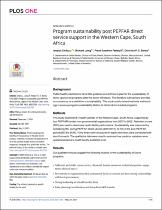| dc.contributor.author | Chiliza, Jessica | |
| dc.contributor.author | Laing, Richard | |
| dc.contributor.author | Feeley III, Frank Goodrich | |
| dc.date.accessioned | 2022-07-19T07:54:52Z | |
| dc.date.available | 2022-07-19T07:54:52Z | |
| dc.date.issued | 2021 | |
| dc.identifier.citation | Chiliza, J. et al. (2021). Program sustainability post PEPFAR direct service support in the Western Cape, South Africa. PLos One, 16(5), e0251230. 10.1371/journal.pone.0251230 | en_US |
| dc.identifier.issn | 1932-6203 | |
| dc.identifier.uri | 10.1371/journal.pone.0251230 | |
| dc.identifier.uri | http://hdl.handle.net/10566/7608 | |
| dc.description.abstract | Public health practitioners have little guidance around how to plan for the sustainability of
donor sponsored programs after the donor withdraws. The literature is broad and provides
no consensus on a definition of sustainability. This study used a mixed-methods methodology
to assess program sustainability factors to inform donor-funded programs.This study examined 61 health facilities in the Western Cape, South Africa, supported by
four PEPFAR-funded non-governmental organizations from 2007 to 2012. Retention in care
(RIC) was used to determine health facility performance. Sustainability was measured by
comparing RIC during PEPFAR direct service (20072012), to RIC in the post PEPFAR
period (2013 to 2015). Forty-three semi-structured in-depth interviews were conducted with
key informants. The qualitative data were used to examine how predictor variables were
operationalized at a health facility and NGO level. | en_US |
| dc.language.iso | en | en_US |
| dc.publisher | Public Library of Science | en_US |
| dc.subject | Public health | en_US |
| dc.subject | Sustainability | en_US |
| dc.subject | Donor-funded programs | en_US |
| dc.subject | HIV | en_US |
| dc.subject | Western Cape | en_US |
| dc.title | Program sustainability post PEPFAR direct service support in the Western Cape, South Africa | en_US |
| dc.type | Article | en_US |

